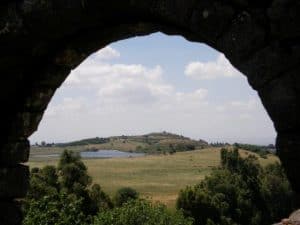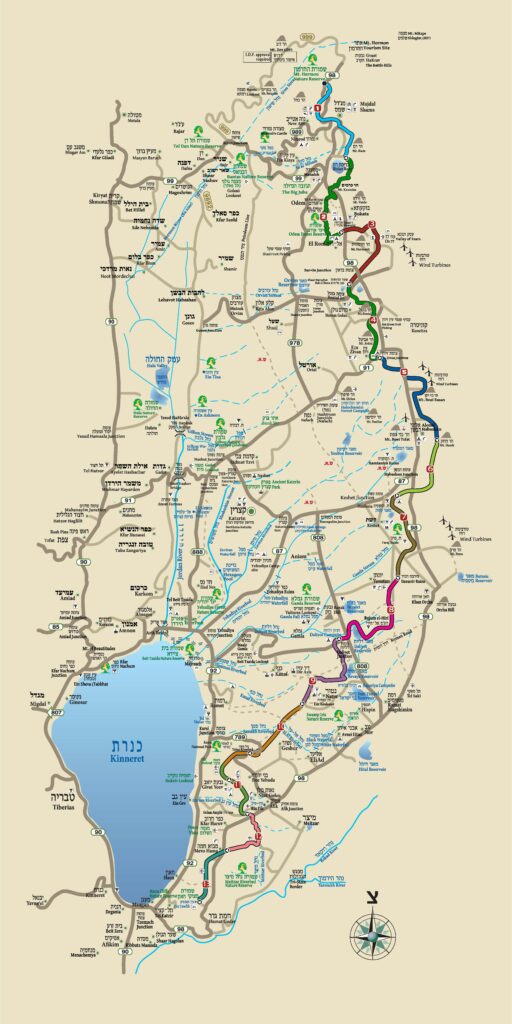The Golan Trail
home page / The Golan Trail
The Golan Trail is a marked path that stretches for 120 kilometers with breathtaking scenery. Hikers on the Golan Trail can see views of Mt. Hermon and Lake Kinneret, volcanos and reservoirs, wildflowers and archaeological sites.
The trail begins in the north on Mt. Hermon, and ends with a view of Lake Kinneret in the south; the path is marked with blue, white and green stripes. The Golan Trail has become a popular “pilgrimage hike” in recent years.
The recommended season for hiking the trail is spring, especially the months of March and April. At this time of year, the Golan is “painted” green, and wildflower blooming is at its peak.
The southern segments of the Golan Trail can be hiked in the winter (from October to February), too. Since this area is about 300-400 meters above sea level, the winters are relatively mild (except for rainy days).
The northern segments can be hiked in May, throughout the summer, and again in September.
Most of the northern segments are at a height of 1,000 meters above sea level, and the summers are relatively mild; many of the segments are heavily shaded.
The Golan Trail is divided into 15 segments of different lengths, all between 6 and 11 kilometers per segment. Each segment has a starting and ending point that is accessible by car; if there are two cars, one can be left at the end for convenience.
People still hitchhike safely in the Golan, but there is also public transportation that can help hikers at the beginning and ending of most trails.
Each segment can be hiked in a day or less, and the difficulty level is usually easy-to-intermediate. Advanced hikers can finish two segments per day (we don’t recommend hiking any more than two segments at a time).
for Golan Trail map– https://did.li/6nCCN
For those hiking “with their homes on their backs”, the Golan Trail usually takes about 7-9 days to finish; there are free camping sites along the way.
But the Golan also offers many diverse kinds of lodgings: one can stay at a paid campsite with minimum creature comforts, or one can stay at a fancy B&B; both options can be found relatively near the trail.
For those hiking the Golan Trail, one must have an updated version of Trail Map #1 (the map with the official trails marked clearly), which is updated from time to time. Another possibility is to have an app on your smartphone that includes the same trail markings and information that are on the physical map.
While hiking in the Golan, it is absolutely forbidden to cross fences or go off the marked trail;
in a number of places, the trail is not far from well-signed minefields (which are all marked on official maps and apps).
For more information in English on the Golan Trail, Click here

North

Segment #1: From Mt. Hermon to the Yaafuri Valley
A taste of Hermon in Nachal Govta, a scenic view from Maaleh Golani, the Druze village of Majdal Shams, and the Yaafuri Valley. Difficulty: from

Segment #2: From the Yaafuri Valley to the 7th Brigade Recon Memorial.
A lookout over the “Blue Eye” of Birket Ram, an enchanted forest, and a climb up Mt. Odem. Difficulty: From north to south – medium;

Segment #3: From the 7th Brigade Recon Memorial to Bab el-Hawa
A hike through vineyards, memorial sites in the Valley of Tears, and 1500 years of history at the Gate of the Winds. Difficulty:

Segment #4: From Bab el-Hawa to the Ein Zivan Campsite
A water reservoir, walking on volcanoes, and a beautiful oak forest Difficulty: From north to south – medium/difficult; from south to north – medium/difficult. Duration
Center

Segment #5: From the Ein Zivan Campsite to Mt. Hozek
Hike between apple orchards, wind turbines, and Mediterranean trees and bushe Difficulty: From north to south – medium; from south to north – easy Duration

Segment #6: From Mt. Hozek to the Hushniya Ruins
From the Bashanit Range with stately oaks, via the Golan Iris Nature Reserve, to the ruins of a Circassian mosque. Difficulty of hike: From north

Segment #7: From the Hushniya Ruins to Um el-Dananir
Ruins of ancient villages, flowing springs, and wide-open spaces. Difficulty: From north to south – easy; from south to north – easy Duration of hike:

Segment #8: From Um el-Dananir to the Daliyot Campsite
Flat plains of the central Golan, grazing horses, and mysterious circles of ancient rocks Difficulty: From north to south – easy; from south to north

Segment #9: From the Daliyot Campsite to Ein Keshatot
The Grand Canyon of the Golan, a Syrian Bridge to Divert the Jordan River Headwaters, and a Magnificent Ancient Synagogue. Difficulty: From north to south
South

Segment #10: From Ein Keshatot to Mitzpe Ofir
From Ein Keshatot to Mitzpe Ofir: Beautiful Natural Views of Nachal Samakh, Pools at a Riverbed Junction, and a Lookout towards Lake Kinneret. Difficulty: From

Segment #11:From Mitzpe Ofir to the Golan Amphitheater
Views of Lake Kinneret, Nachal Ein Gev, and the Watershed Difficulty: .From north to south – medium; from south to north – medium Duration of

Segment #12: From the Golan Amphitheater to Mevo Hama
An Oak Forest at the Narrow Waist of the Golan, a View Towards the Yarmukh River, and a Peak Towards our Neighbors in the East

Segment #13: From Mevo Hama to Ein Akub (Ein Tawfik)
500 Meters above Lake Kinneret on a Paragliders’ Cliff, and a Refreshing Spring Difficulty: From north to south – easy; from south to north –






